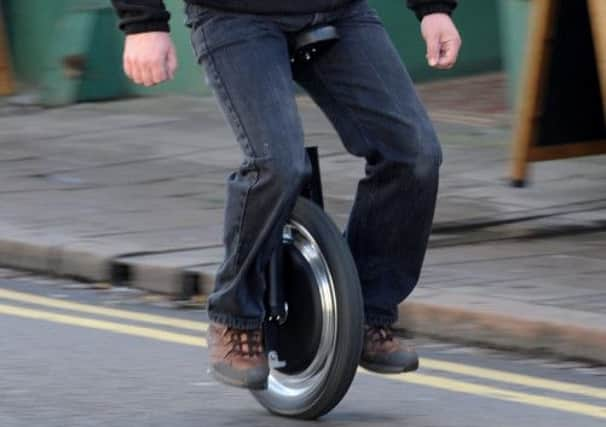Electric unicycle billed to beat traffic congestion


The electric unicycle has a top speed of about 12mph, a battery that lasts for up to ten miles and is small enough to be stored under a desk. Sellers say it would be good for office staff looking for a fun, new way to get to work.
The SBU V3 – to give it its proper name – will set buyers back £1,685, and users are advised to wear a protective helmet.
Advertisement
Hide AdAdvertisement
Hide AdInvented in the United States, it was snapped up by the Electric Transport Shop in Cambridge after staff trialled it at the Cycle Show in Birmingham last month.
Manager Adam Wolfe said: It has certainly created a buzz.”
However, it’s not simply a case of getting on the one-wheeler and riding away. There is the fine art of balancing to perfect.
“It takes about 20 to 30 minutes of practising to really get the hang of it,” Mr Wolfe said.
“After that, I would say it would be another two to three hours before a person should venture out on to the roads on it.
“We think it should be a great hit with commuters looking for a way to beat the traffic queues as well as an alternative way to travel to work.”
The shop’s founder, Jamie McAlley, said: “It’s easy to use once you get the hang of it.
“You can take it on the train and it’s small enough to put inside the office once you get to work. There’s no reason why it can’t be the future.”
Mr McAlley, one of the first owners of the SBU V3, which is to be featured on Channel 5’s Gadget Show next week, said the rider moved the unicycle by leaning forward to go, back to stop and left and right to steer.
Advertisement
Hide AdAdvertisement
Hide AdBut he said it was unclear whether it was legal to use the unicycle on the road.
The DVLA said it did not think the machine was roadworthy. A spokesman said: “This unicycle does not appear to be designed for road use. Vehicles cannot be used on public roads unless they meet the necessary requirements, for example on braking, steering and lighting, to ensure that they are safe and roadworthy.”
The unicycle also received a lukewarm response from Green councillor Gavin Corbett, from Edinburgh, who said: “The saying goes that we need to walk before we can run and, in this case, I think we need to bicycle before we unicycle.”
The electronic unicycle is the latest in a long line of congestion-busting inventions. And not all of them have taken off.
Back in the 1980s, the Sinclair Research C5, a battery-powered electric vehicle, was a commercial disaster, selling only about 17,000. Despite being promoted by former Formula 1 racing driver Stirling Moss, the feeling was that the C5 was impractical in the British climate and possibly dangerous on busy roads.
Then in 2001, came the Segway, a two-wheeled machine that promised to revolutionise transport around cities as it was quick, environmentally friendly and easy to balance.
The £5,000 Segway, which can reach speeds of 12mph, became legal to ride on pavements in more than 40 US states, as well as many countries in Europe.
In Britain, they were classed as motor vehicles under the Highways Act 1835, preventing them from being used on pavements, but they were also barred from the road as they did not comply with road traffic law.
Advertisement
Hide AdAdvertisement
Hide AdThe most recent invention was the TF-X, unveiled in May this year, a plug-in hybrid tilt- rotor vehicle designed to become the first fully autonomous flying car. It is not scheduled to hit the market until 2021.